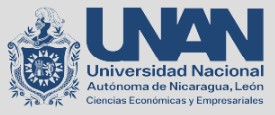Beekeeping in western Nicaragua, the experience of rural producers in the municipality of El Viejo
DOI:
https://doi.org/10.5377/aes.v1i2.11446Keywords:
production, marketing, beekeeping, organizationAbstract
Honey is a very old natural product. In the Nicaraguan context, organic beekeeping is the most practiced, although only 19% of production is duly certified and only 31% of beekeepers are certified to distribute organic honey. The municipality of El Viejo is one of the main centers of concentrations of hives in the western area, making beekeeping a common practice in the region among producers in the area. Honey is the most popular product derived from beekeeping production, which is why this study is driven to give greater prominence to this area, and being of agro-industrial nature, the analysis of its production process and subsequent commercialization is considered vitally important to understand in a clearer way all the links involved in the transformation, which increasingly has a presence within the country's export range. The study is descriptive, quantitative in nature and non-experimental in design, with the interview applied to an official of Fundación Lider and the survey of 49 honey producers in the area, being used as information-gathering tools. The beekeepers under study are organized mostly collectively, associated under the tutelage of Fundación Líder, that provides them with materials and supplies, it is evident that there are factors that affect honey production in a negative way, especially the periods of drought and strong winds that cause an increase in mortality in bees, beekeeping in this area is characterized by artisanal production and a short marketing chain.
Downloads
References
Anacafé. (2004). portal.anacafé. Obtenido de http://portal.anacafe.org/Portal/Documents/Documents/2004-
Barragán, M. (2017). Apicultura Campesina una alternativa para el desarrollo rural. Colombia: Santander.
CECASEM. (julio de 2013). saludpublica. Obtenido de saludpublica: http://saludpublica.bvsp.org.bo/cc/bo40.1/documentos/584.pdf
Cuenta Reto del Milenio. (25 de octubre de 2017). cenida. Obtenido de https://cenida.una.edu.ni/relectronicos/RENL01B715.pdf
Martínez, A. (01 de junio de 2015). Clima afecta producción de miel. FIN, pág. 1.
Romero, M. (2016). La crianza de abejas como estrategia de diversificación : análisis de las cadenas de miel en El Tuma-La Dalia. Nitlapán UCA, 2.
Swiscontact Nicaragua. (2010). mific. Obtenido de mific: http://www.mific.gob.ni/Portals/0/Portal%20Empresarial/estudio%20mercado%20de%20
Published
How to Cite
Issue
Section
License
Copyright (c) 2020 National Autonomous University of Nicaragua, UNAN León

This work is licensed under a Creative Commons Attribution-NonCommercial-ShareAlike 4.0 International License.














